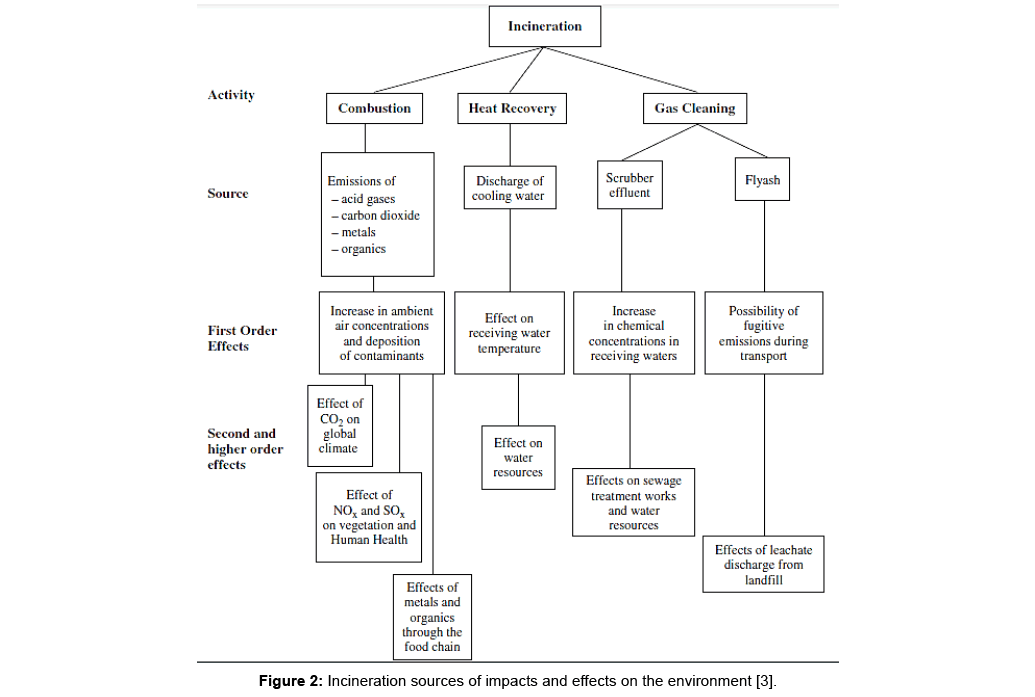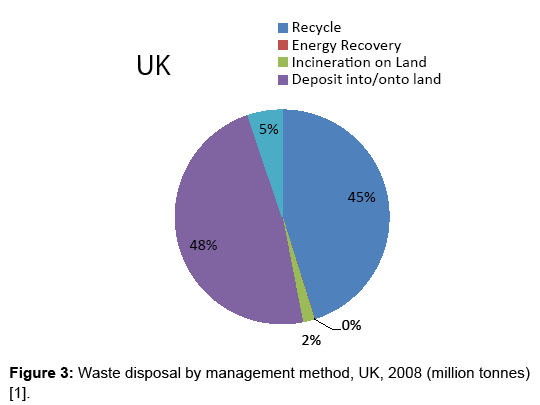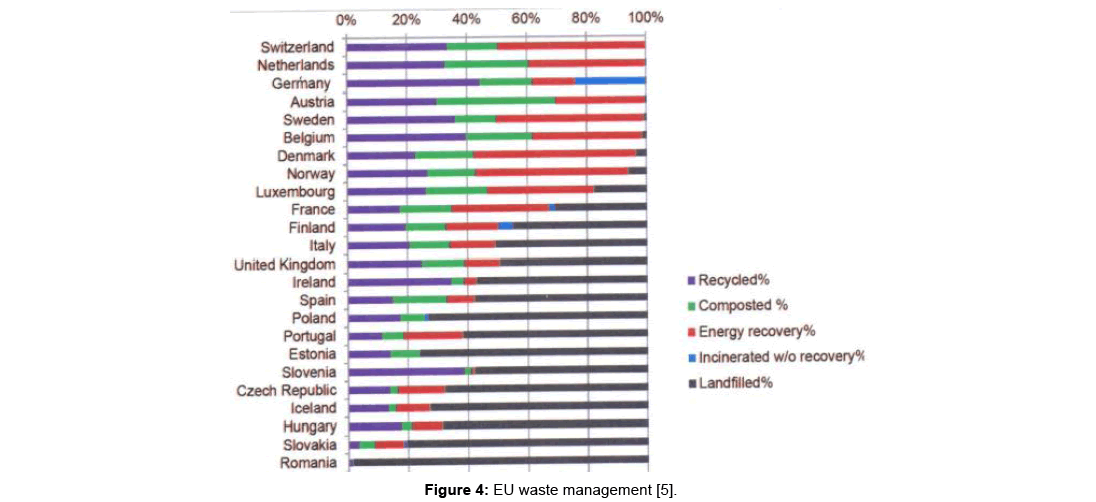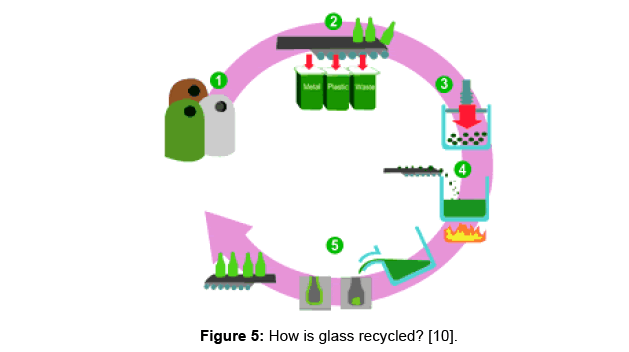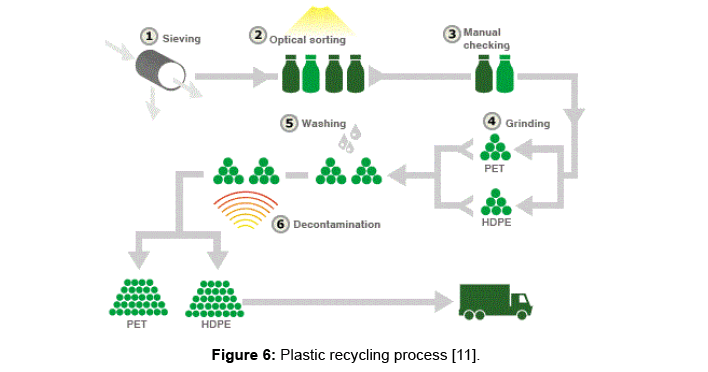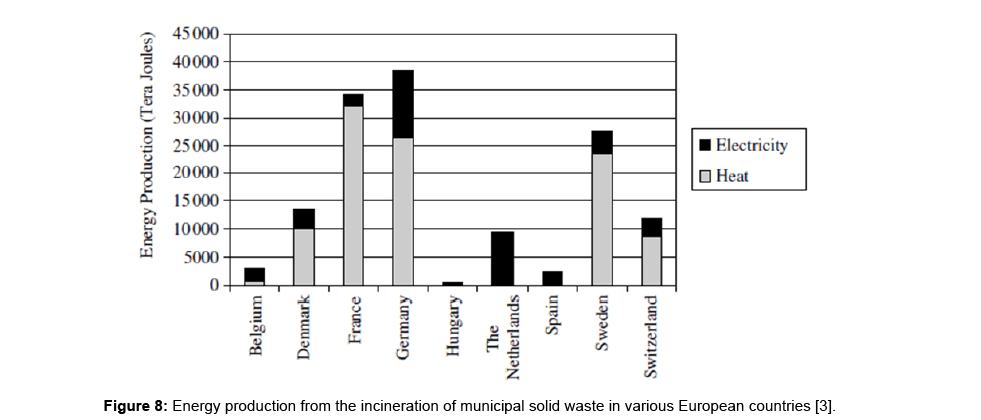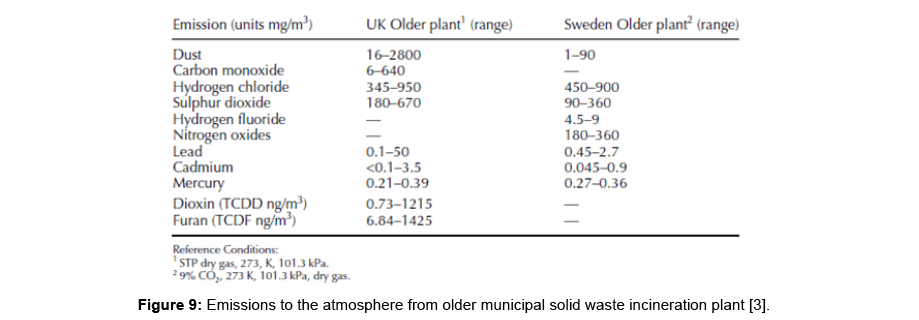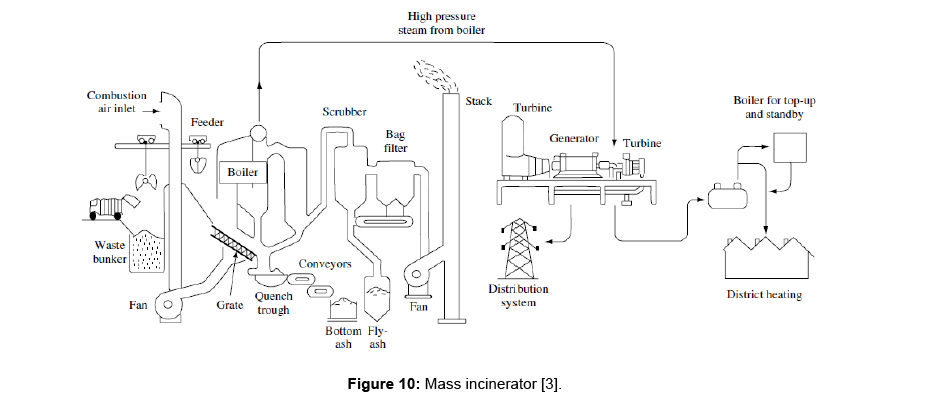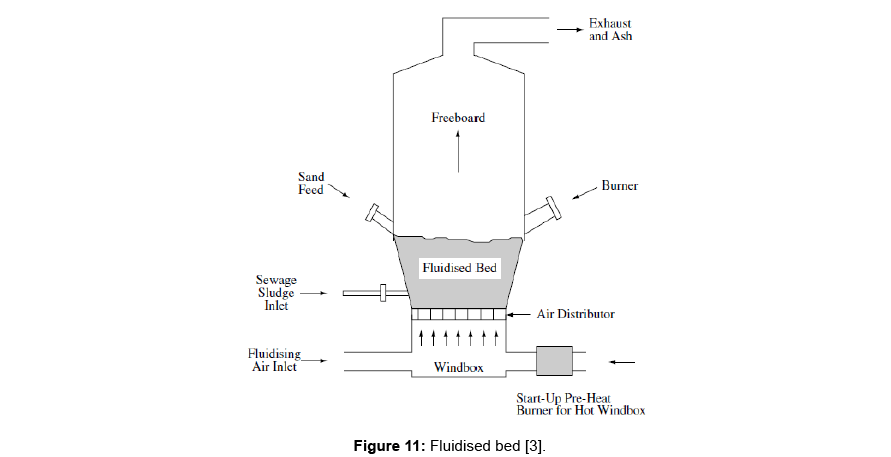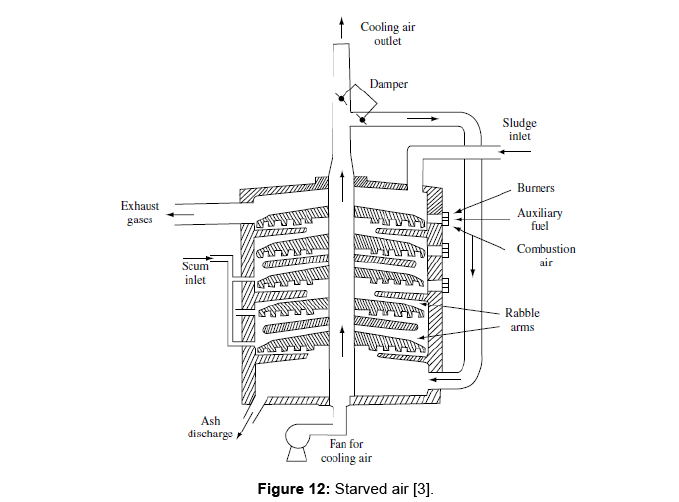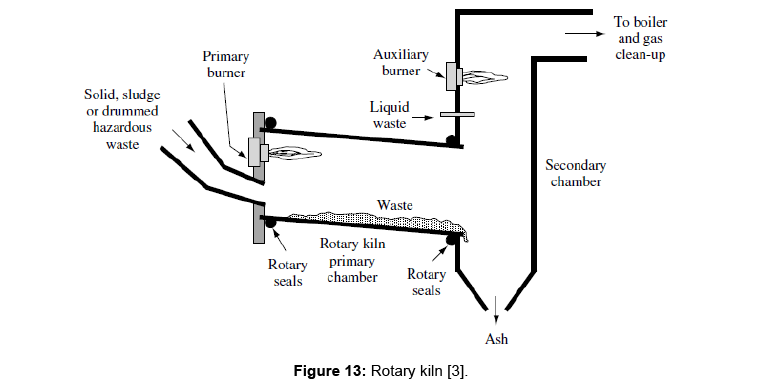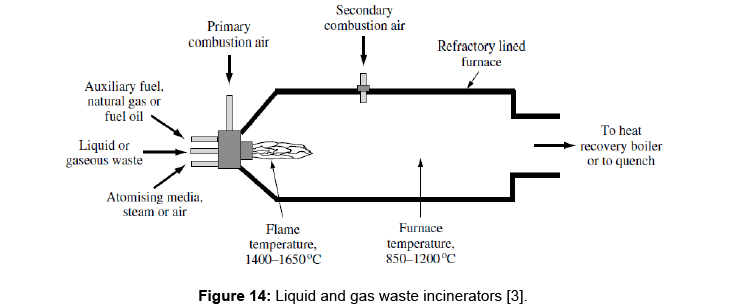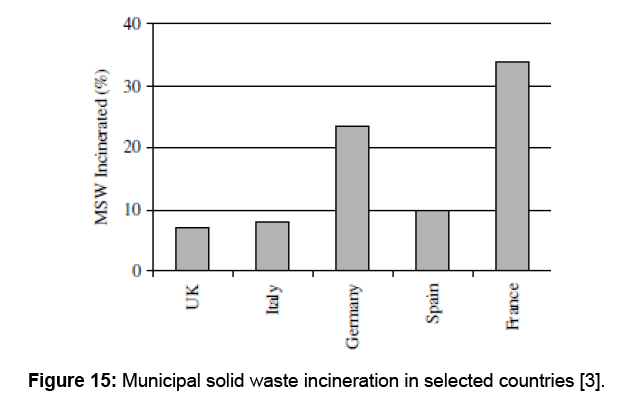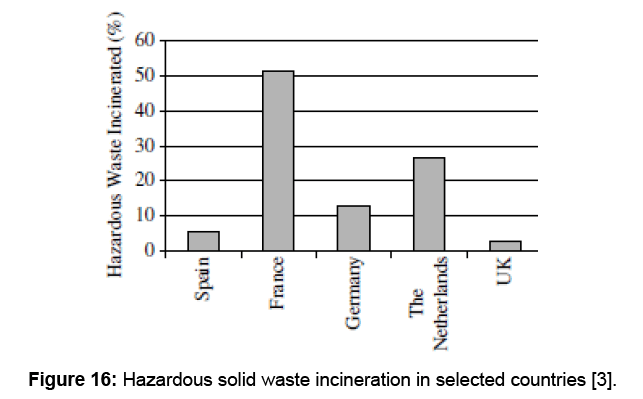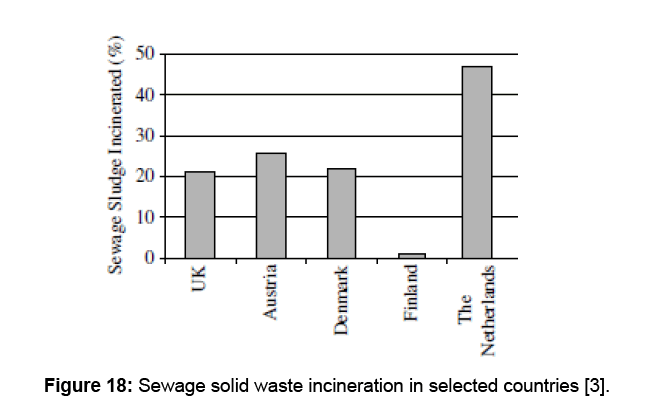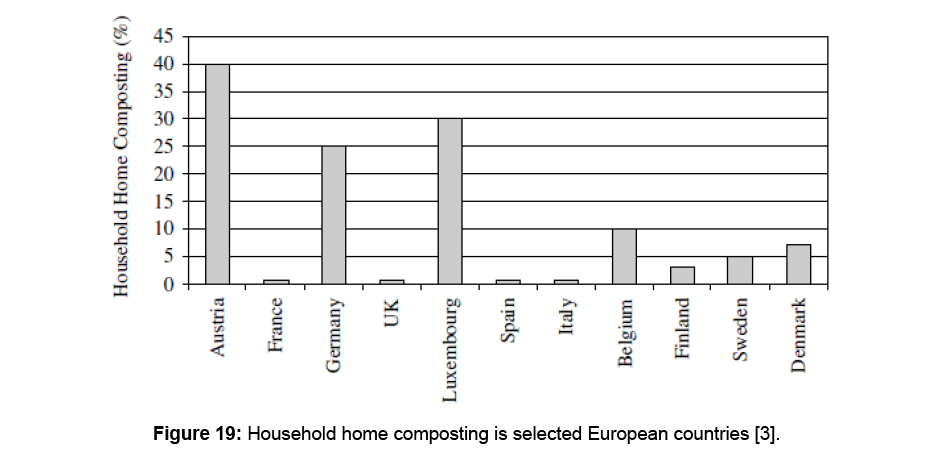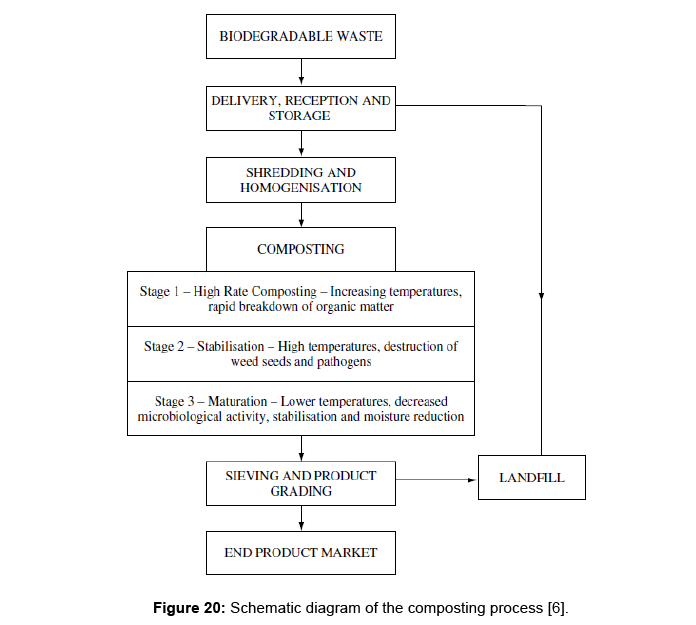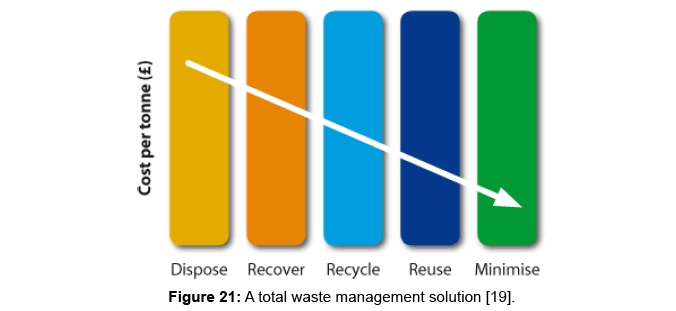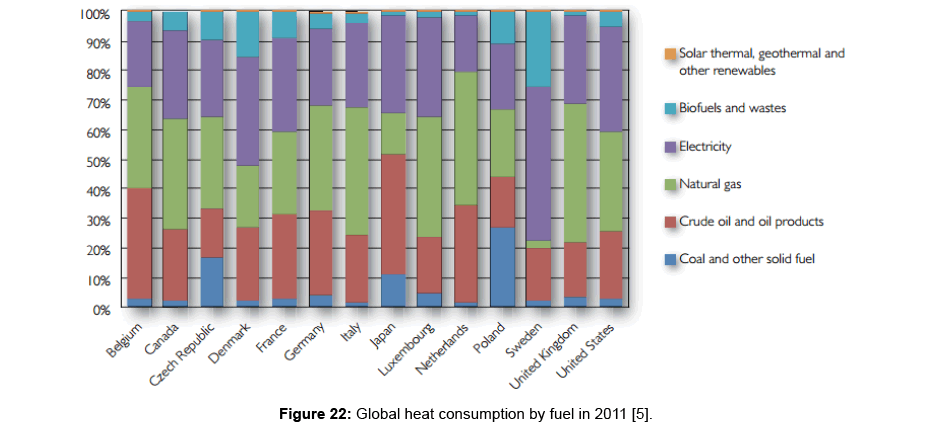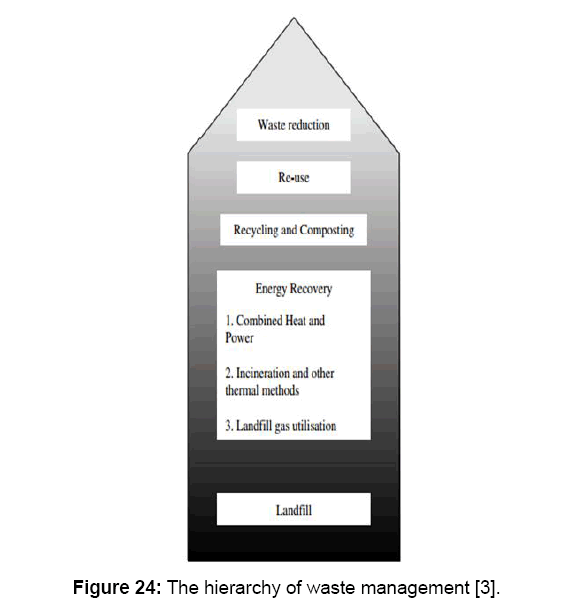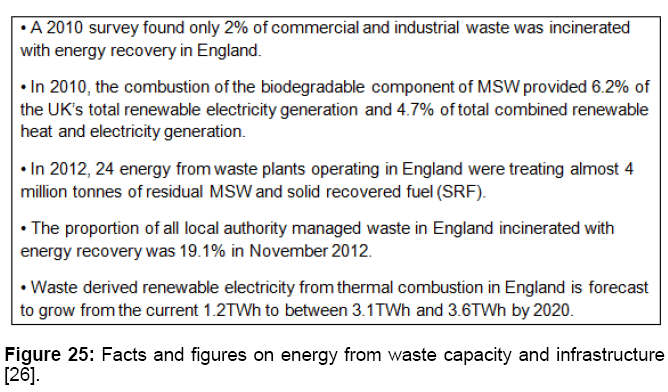Technical Discussion over Three Means of Waste Management
Received: 02-Dec-2017 / Accepted Date: 15-Dec-2017 / Published Date: 26-Dec-2017 DOI: 10.4172/2157-7625.1000225
Abstract
The present investigation is an effort to compare between three different ways of waste management: Recycling/ re-use, incineration and composting. Re-use gives the impression to have more beneficial factors than the other methods. Nevertheless, incineration is regarded as an effective alternative that converts waste into energy, hence improves the economy and preserve the environment by the use of modern gas-cleaning technology. Recycling has been found to be of less social demand, and composting has higher negative environmental impact and deals with smaller amounts of waste for longer periods of time.
Keywords: Â Waste; Recycle; Incineration
Introduction
In 2011, the UK has generated 288.55 million tonnes of waste in year 2008, 2.2% of it was considered as hazardous waste. Most of the waste was generated by constructions (about 35% of the total waste), whereas about 61% of the total waste has been found to be mineral waste [1].
The aim of this paper is to explore the routes of recycling/reuse, incineration, and composting. The study will be limited to the technical, economical, and environmental factors. After brief scientific definitions, this paper will try to compare between the factors. Firstly, the technical aspect will be examined based on the procedures followed by each method. Secondly, the economical aspect will be explored, hopefully, to point towards how different methods can affect the countries money matters, by either saving, or costing them. Lastly, the individual impacts on the planet will be identified. Diagrams, figures, charts and conclusions will also be provided summing the main objectives observed in the UK.
Technical Discussion
Part one-technical definitions
What is waste: Waste, in general, consists of all matters that are of no further use to the persons, these materials are therefore going to be discarded. Waste sources are quite different and varieties of waste types are being generated everyday all around the world, for instance municipal waste is generated by houses [2].
Recycling/re-use: Re-use refers to the procedure of collecting, cleaning, and re-using the used product, such as the multiple-use of glass bottles. It might also refer to a new usage for the product once it has served its initial purpose, such as the use of used tyres as silage covers [3]. According to ETC/SCP [2], it minimises the amount of daily waste discarded. Recycling involves waste recovery and processing to a new marketable product (Figure 1). Recycled materials require market demand; otherwise the process will cost money and energy with no environmental achievement [3]. Recycling can be done on organic wastes, but with no energy recovery (ibid). In addition, waste heat from plants can also be recycled and re-used as an essential feature of a highly-efficient thermal power station [4,5].
Waste incineration: Waste treatment by incineration is the process of burning waste (most often burning the unrecyclable waste) under controlled conditions [6]. Incineration is a widely used process aiming to reduce the large amounts of waste, hence to reduce the likelihood of infection or poisoning by medical and hazardous waste [7]. In 2000, the National Research Council listed the typical processes in each waste incinerator, due to the fact that different waste sources require different types of incinerators. Williams [3] details the main activities, sources, and effects behind incineration (Figure 2).
Figure 2: Incineration sources of impacts and effects on the environment [3].
Composting: The US environmental protection agency [6] defines composting as the aerobic controlled process of decomposing biological organic matters to form a ‘humus-like’ material. According to Williams, it takes about 4-6 weeks to reach a stabilised product [3]. The process can also be anaerobic when the materials to be composed are from human waste [8].
Composting process is only applicable for non-hazardous, putrescible solid wastes such as crop residues, leaves, grass, animal manures and human waste [8]. Figure 3 shows the extents to which these methods are applied in the UK in 2008, while Figure 4 shows the general situation in some EU countries.
Figure 3: Waste disposal by management method, UK, 2008 (million tonnes) [1].
Figure 4: EU waste management [5].
Part two-distinguishing factors
In 2011, the UK has generated 288.55 million tonnes of waste in year 2008, 2.2% of it was considered as hazardous waste. Most of the waste was generated by constructions (about 35% of the total waste), whereas about 61% of the total waste has been found to be mineral waste [1].
The aim of this paper is to explore the routes of recycling/reuse, incineration, and composting. The study will be limited to the technical, economical, and environmental factors. After brief scientific definitions, this paper will try to compare between the factors. Firstly, the technical aspect will be examined based on the procedures followed by each method. Secondly, the economical aspect will be explored, hopefully, to point towards how different methods can affect the countries money matters, by either saving, or costing them. Lastly, the individual impacts on the planet will be identified. Diagrams, figures, charts and conclusions will also be provided summing the main objectives observed in the UK.
Technical Discussion
Part one-technical definitions
What is waste: Waste, in general, consists of all matters that are of no further use to the persons, these materials are therefore going to be discarded. Waste sources are quite different and varieties of waste types are being generated everyday all around the world, for instance municipal waste is generated by houses [2].
Recycling/re-use: Re-use refers to the procedure of collecting, cleaning, and re-using the used product, such as the multiple-use of glass bottles. It might also refer to a new usage for the product once it has served its initial purpose, such as the use of used tyres as silage covers [3]. According to ETC/SCP [2], it minimises the amount of daily waste discarded. Recycling involves waste recovery and processing to a new marketable product (Figure 1). Recycled materials require market demand; otherwise the process will cost money and energy with no environmental achievement [3]. Recycling can be done on organic wastes, but with no energy recovery (ibid). In addition, waste heat from plants can also be recycled and re-used as an essential feature of a highly-efficient thermal power station [4,5].
Waste incineration: Waste treatment by incineration is the process of burning waste (most often burning the unrecyclable waste) under controlled conditions [6]. Incineration is a widely used process aiming to reduce the large amounts of waste, hence to reduce the likelihood of infection or poisoning by medical and hazardous waste [7]. In 2000, the National Research Council listed the typical processes in each waste incinerator, due to the fact that different waste sources require different types of incinerators. Williams [3] details the main activities, sources, and effects behind incineration (Figure 2).
Composting: The US environmental protection agency [6] defines composting as the aerobic controlled process of decomposing biological organic matters to form a ‘humus-like’ material. According to Williams, it takes about 4-6 weeks to reach a stabilised product [3]. The process can also be anaerobic when the materials to be composed are from human waste [8].
Composting process is only applicable for non-hazardous, putrescible solid wastes such as crop residues, leaves, grass, animal manures and human waste [8]. Figure 3 shows the extents to which these methods are applied in the UK in 2008, while Figure 4 shows the general situation in some EU countries.
Part two-distinguishing factors
The technical factor: Obviously, for something to be re-used in its initial form, no technology is needed to be supplied (e.g., books and plastic bottles). However, if the initial shape is to be changed, technologies are applied and procedures are followed.
No single method is implied for recycling; different procedures are present depending on the type of the material to be recycled. For instance, the recycling technology for concrete aggregate, bricks and the like is represented by crushing via crushing machine. Small sizes of concrete can then be used as gravel for constructions. On the other hand, batteries are extremely difficult to recycle due to the large variation in their types and sizes; where each requires an individual recycling route depending on the chemicals involved [9]. Glass cullet commonly undergoes purity monitoring, impurities removal, followed by the processes of mechanical crashing and melting in furnace with a raw material mix. Finally, it is moulded into new jars or bottles (Figure 5).
Figure 5: How is glass recycled? [10]. Figure 6:
Down cycling is a process where paper is recycled by mixing with an amount of a virgin material. Recovering scrap is the first step for plastic recycling, followed by reprocessing into valuable products. Like batteries, large variety plastic types are present; all have to be sorted prior to recycling (Figure 6). However, only few plastic recycling facilities exist, and that might be for the reason that recycled plastic is less likeable to manufacturers than new plastic (ibid). Furthermore, municipal solid waste can also be recycled according to the following example procedures, through which 15% of the municipal solid waste can be recycled (Figure 7) [3].
Figure 6: Plastic recycling process [11].
Figure 7: Design of an unsegregated municipal solid waste recycling facility [3].
Although incineration process looks simple, many considerations must be taken into account, mainly is the energy efficiency; to get authorisation, incinerators must be efficient and recover energy (i.e., recover electricity or heat as much as possible) (Figure 8) [10-12].
Figure 8: Energy production from the incineration of municipal solid waste in various European countries [3].
Veolia Environmental Services in Sheffield [13] describes the incineration procedure as follows: rubbish is brought and fed into storage bunker. Then it is lifted by crane and fed into a feed hopper, then into a single incineration unit and burnt (<850°C) (depending on the type of the incinerator). Inside the combusting chamber, waste is firstly dried by the elevated temperature, followed by the volatile matter removal and gasification; results in the production of heat and undesirable gases (Such as NOx and CO2). A large boiler is attached above the incinerator in which the superheated steam is generated. The steam is the key driving force to drive the turbine, hence generating electricity for the National Grid, as well as producing hot water for the district energy network. The flue gases are then processed in gas- cleaning systems to remove toxic materials and reduce NOx, CO2 and other emissions, temperature reduction also occurs in this stage before emitting into the atmosphere (Figure 9). Unlike landfill, no methane (a green-house gas) is produced during the incineration process [3]. The ash produced from the burned waste is sent to landfill. The modern incinerators with efficient gas-cleaning systems can produce heat with inert residue and minimum pollution. In general, incinerators can be classified into two main board types: mass burn (10-15 ton of municipal solid waste/h) and other types (1-2 ton of clinical, sewage sludge and hazardous waste/h).
Figure 9: Emissions to the atmosphere from older municipal solid waste incineration plant [3].
The other types includes: fluidised bed, starved air, rotary kiln, and liquid and gas incinerators. Figures 10-14 shows the typical examples of the different waste incinerator types.
Figure 10: Mass incinerator [3].
Figure 11: Fluidised bed [3].
Figure 12: Starved air [3].
Figure 13: Rotary kiln [3].
Figure 14: Liquid and gas waste incinerators [3].
In 2003, statistics have shown that many European countries have been developing waste incinerators (for different types of waste) on larger scales than the UK (Figures 15-18) [3].
Figure 15: Municipal solid waste incineration in selected countries [3].
Figure 16: Hazardous solid waste incineration in selected countries [3].
Figure 17: Industrial solid waste incineration in selected countries [3].
Figure 18: Sewage solid waste incineration in selected countries [3].
The US environmental protection agency [12] introduces the composting process to be consist of mechanical mixing, followed by ventilating the materials in means of dropping into vertical chains of aerated chambers, or by simply placing the compost in outdoor piles fronting open air, and turning it from time to time. Figure 19 shows statistics of European composting. California Department of Resources Recycling and Recovery [14] states that when composting is being managed effectively, it guarantees that the final product can be returned into the environment safely (Figure 20).
Figure 19: Household home composting is selected European countries [3].
Figure 20: Schematic diagram of the composting process [6].
The composting process is when the non-hazardous biodegradable waste is composed in an open pile and is decomposed by ‘natural biological processes’ [8]. It states that the waste is then broken down by the action of a diversity of microscopic and bacteria, and converted into a stabilised material which can be used as fertiliser.
In terms of economics: Defra draw the attention to waste as part of the economy; it considers waste as a by-product from economic activity (like households), as well as an input (such as energy recovery) [15]. Based on this, it states that waste management has economic implications. ECOTEC Research and Consulting Limited [16] list the costs of the three different routes for the year 1999 (Table 1). The main objectives are that in recycling, there is the cost of the collection systems, and the cost varies depending on the type of the system. Furthermore, bringing waste to the recycle centre requires no separation costs and no sales income.
| Collection system | Collection cost (£/t) |
Separation cost (£/t) |
Sales income (£/t) | Recycling cost (£/t) |
|---|---|---|---|---|
| Bring | 18-41 | 0 | 0 | 18-41 |
| Blue box | 69-173 | 58 | 29 | 98-201 |
| Green bin | 29-46 | 58 | 23 | 63-81 |
| Green bag | 29-52 | 58 | 23 | 63-86 |
£: Pound; t: Tons.
Table 1: Summary of Recycling Costs in 1999 [16].
The research also reveals that incineration costs in London in 1998 was about 25 £/ton for collection, 44 £/ton for incineration, 13 £/ton for residual ash disposal, and 15 £/ton from the sale of heat and power. Table 2 lists the cost of two routes of waste disposal by incineration.
| Incineration | Cost per ton (£) |
|---|---|
| Mass incineration | 17-23 |
| Energy recovery | 23-34.5 |
Table 2: Costs of Waste Disposal by incineration in 1999 [16].
In the same way, different collection, separation and processing methods are available in composting. In the case of waste being brought to the central composting, or home composting, no cost of collection is applied. While split bins to be sent to the central composting, it requires 98 £/ton as collecting cost. However, home composting scored the highest cost in terms of separation comparing with the other methods.
Contradictorily, no sales income arises from home composting, whereas 10£/ton was estimated for the later methods (Table 3).
| Collection system | Collection cost (£/t) |
Separation cost (£/t) |
Sales income (£/t) | Recycling cost (£/t) |
|---|---|---|---|---|
| Central composting (bring waste) |
0 | 16-28 | 10 | 6-18 |
| Central composting | 98 | 16-28 | 10 | 104-115 |
| Home composting | 0 | 52-58 | 0 | 52-58 |
Table 3: Summary of composting Costs in 1999 [16].
NHS London procurement partnership [17] confirms that waste treatment has saved the NHS in London about 5 million pounds (about 20% of the disposal cost) within four years until 2012/2013. Clinical waste is the most expensive type of waste to dispose. In 2008, it cost 1150 £/ton to be treated in the high temperature incineration (Figure 21).
Figure 21: A total waste management solution [19].
Dearden [18] has conducted a research to the UK parliament examining the life cycle assessment (LCA) of recycling against incineration. He concluded that recycling is nearly 60 £/ton cheaper than is incineration or landfill. However, the UK demand for recycled materials has dropped; furthermore, there is no single waste recycling centre in the UK that can handle the increasing amounts of waste [19].
On the other hand, the UK government aims to extract the most energy of residual waste. This reflects the desire to prevent, reuse and recycle at the first step. Efforts are positioned towards reducing waste sent to landfill and meeting the 2020 Waste Framework Directive targets to reuse, recycle or compost 50% of waste from households. In 2010, the UK recycled 39% and incinerated 12% of its waste [20].
Energy from waste incinerators can be of high value. The smallest incinerator in the UK deals with about 25,000 ton/year and the largest about 600,000 ton/year, with efficiencies between 18-27% when generating electricity only (ibid). However, due to the incinerators high capital investment, it is considered as a more expensive option than the others [3]. Generally, the dependence on waste as an energy source is increasing in the UK (Figure 22). In the main, waste incineration is considered a core element in a sustainable energy system in Copenhagen. According to Copenhagen Energy Ltd. [21], waste incineration covered about 30% of the heat demand in the municipal of Copenhagen in 2009.
Figure 22: Global heat consumption by fuel in 2011 [5].
The environmental aspect: The main issue resulted from waste is the environmental damage; waste discarded to landfill produces methane, a powerful greenhouse gas [20], as well as the large volume of clinical waste [17]. However, reduction in the amounts of waste being sent to landfill can effectively minimise the emissions of greenhouse gases evolved from it. According to South Carolina Department of Health and Environmental Control [22] recycling can significantly reduce the necessity to build landfills and incinerators. It can save natural resources.
However, the parliamentary office of science and technology [23] states that although recycling is widely assumed to be environmentally valuable, some environmental impacts and energy usages can rise from the processes of waste collection, sorting and re-processing.
In general, it has been found that noise, odour, dust and soils damaging by recycling processes are unlikely to be significant. However, recycling shows a potentially significant impact in some cases on water and air quality, then again the effect can be controlled. Figure 23 compares between recycling and recovery in terms of Kg CO2 equivalent [24].
Figure 23: Recycling and recovery impact on global [3].
In terms of the incineration process, Environmental Protection Department [25] clearly state that incinerators require proper control processes, as well as efficient gas cleaning systems to avoid pollutant gases from being emitted to the atmosphere; mainly nitrogen oxides, sulphur oxides and carbon dioxide. Nevertheless, with the new technologies and modern control systems, incineration is environmentally regarded as the best practical option for hazardous waste management; such as volatile and infectious waste [3].
Defra [24] shows that incineration is less environmentally friendly than recycling due to dust development; again, with the proper control equipment and the modern incinerators, the impact can be minimised.
On the other hand, composting has a beneficial influence on soil, but not on the air quality. Composting has been observed to be likely noisy, dusty, and of significant impact on the water quality. Overall, it is unlikely to have a damaging influence on the climate; however composting can be regarded as a good environmental option for Green Waste (Figure 24).
Figure 24: The hierarchy of waste management [3].
As a final point, facts and figures on energy from waste capacity and infrastructure have been pointed out by the Defra [26]. The facts are described in Figure 25.
Figure 25: Facts and figures on energy from waste capacity and infrastructure [26].
Conclusions
The amount of waste is increasing every day in parallel with the population and industries increase. In terms of the technological factor, it can be concluded that re-use, followed by composting, require less processes than recycling and incineration. Most of the incinerators processes are alike, whereas recycling processes are widely different depending on the type of waste. In regard to economics, re-use can be considered as the cheapest way. However, incineration can save money due to the energy recovery and the huge amounts of waste it deals with. The environmental factor has revealed that incineration and composting have higher negative impacts on the air quality than recycling. However, incineration has the advantage of modern technology that can control the emissions developed within the incineration process.
Although the technical discussion was limited to only three factors, the paper would have been enhanced, and clearer image would have been drawn, by looking at the political perspective. With all the changes in the countries relationships due to wars and the like, the necessity for the countries to depend on their own economy would be an essential approach. For instance, more dependence on energy from waste, hence new developed methods would save the UK economy in case of any political issue with an energy provider country.
References
- The Department for Environment, Food and Rural Affairs (Defra) (2011) ENV23 - UK statistics on waste.
- EIONET European Topic Centre on Sustainable Consumption and Production (ETC/SCP) (2013) What is waste?
- Williams PT (2005) Waste recycling. Waste Treatment and Disposal, (2nd edn.), pp: 127-170.
- Nasserzadeh V (1996) Measuring gas-residence times in large municipal incinerators, by means of a pseudo-random binary signal tracer technique. Fuel and Energy Abstracts1: 59.
- Department of Energy and Climate Change (2012) The future of heating: A strategic framework for low carbon heat in the UK. London.
- US environmental protection agency (2013) Managing Materials and Wastes for Homeland Security Incidents.
- National Research Council (2000) Waste incineration and public health. Washington, DC: The National Academies Press.
- Open Learn Create (2014) Recovery strategies: recycling, composting and energy.
- California Department of Resources Recycling and Recovery (CalRecycle) (2006) Compost and Mulch.
- The Department for Environment, Food and Rural Affairs (Defra) (2011) The economics of waste and waste policy.
- ECOTEC Research and Consulting Limited (2010) Beyond the bin: The economics of waste management options.
- NHS London procurement partnership (2013) Waste Management slices £5m off waste disposal costs for LPP trusts, and aims for zero waste to landfill.
- Houses of Parliament (2013) Maximising the Value of Recycled Materials.
- The Department for Environment, Food and Rural Affairs (Defra) (2014) Energy from waste: A guide to the debate.
- Copenhagen Energy Ltd. (2009) Copenhagen district heating system. Copenhagen: Public-Owned Limited Company.
- South Carolina Department of Health and Environmental Control (2014) Environmental benefits of recycling.
- The Parliamentary Office of Science and Technology (2005) Recycling household waste
- The Department for Environment, Food and Rural Affairs (Defra) (2004) Review of environmental and health effects of waste management: Municipal solid waste and similar wastes.
- Environmental Protection Department (2005) Incineration Technology and Emissions.
- The Department for Environment, Food and Rural Affairs (Defra) (2013) Energy from waste: A guide to the debate.
Citation: Affan FB (2017) Technical Discussion over Three Means of Waste Management. J Ecosyst Ecography 7: 244. DOI: 10.4172/2157-7625.1000225
Copyright: © 2017 Affan FB. This is an open-access article distributed under the terms of the Creative Commons Attribution License, which permits unrestricted use, distribution, and reproduction in any medium, provided the original author and source are credited.
Share This Article
Recommended Journals
Open Access Journals
Article Tools
Article Usage
- Total views: 10981
- [From(publication date): 0-2017 - Mar 31, 2025]
- Breakdown by view type
- HTML page views: 10092
- PDF downloads: 889


